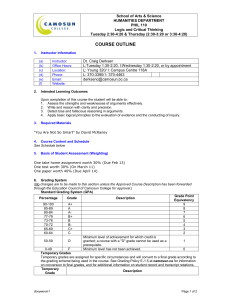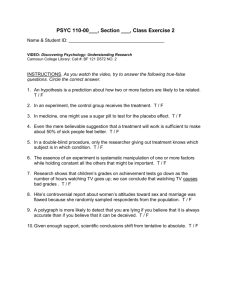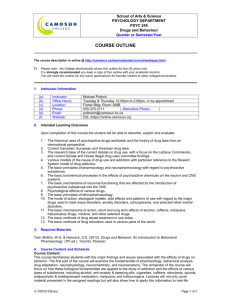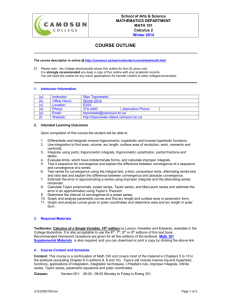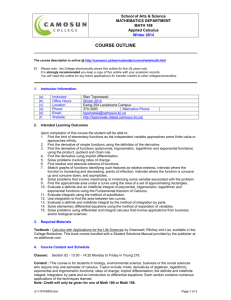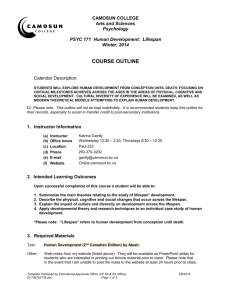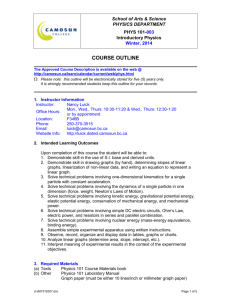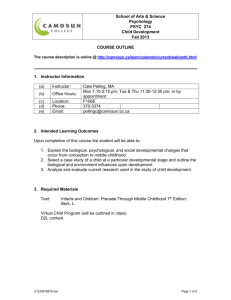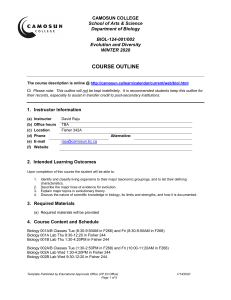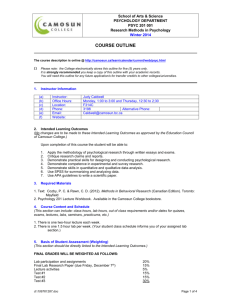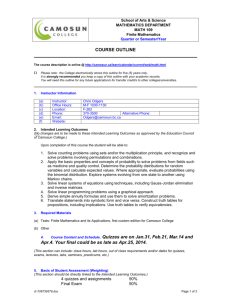PHYS-104 - Camosun College
advertisement
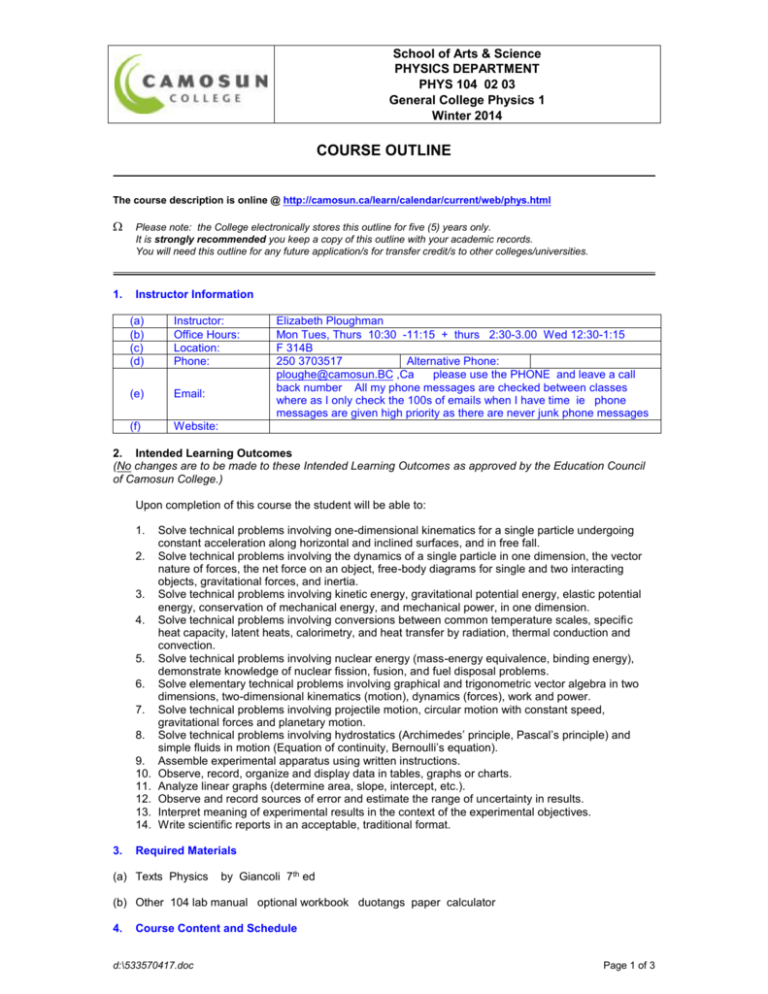
School of Arts & Science PHYSICS DEPARTMENT PHYS 104 02 03 General College Physics 1 Winter 2014 COURSE OUTLINE The course description is online @ http://camosun.ca/learn/calendar/current/web/phys.html 1. Please note: the College electronically stores this outline for five (5) years only. It is strongly recommended you keep a copy of this outline with your academic records. You will need this outline for any future application/s for transfer credit/s to other colleges/universities. Instructor Information (a) (b) (c) (d) Instructor: Office Hours: Location: Phone: (e) Email: (f) Website: Elizabeth Ploughman Mon Tues, Thurs 10:30 -11:15 + thurs 2:30-3.00 Wed 12:30-1:15 F 314B 250 3703517 Alternative Phone: ploughe@camosun.BC ,Ca please use the PHONE and leave a call back number All my phone messages are checked between classes where as I only check the 100s of emails when I have time ie phone messages are given high priority as there are never junk phone messages 2. Intended Learning Outcomes (No changes are to be made to these Intended Learning Outcomes as approved by the Education Council of Camosun College.) Upon completion of this course the student will be able to: 1. 2. 3. 4. 5. 6. 7. 8. 9. 10. 11. 12. 13. 14. 3. Solve technical problems involving one-dimensional kinematics for a single particle undergoing constant acceleration along horizontal and inclined surfaces, and in free fall. Solve technical problems involving the dynamics of a single particle in one dimension, the vector nature of forces, the net force on an object, free-body diagrams for single and two interacting objects, gravitational forces, and inertia. Solve technical problems involving kinetic energy, gravitational potential energy, elastic potential energy, conservation of mechanical energy, and mechanical power, in one dimension. Solve technical problems involving conversions between common temperature scales, specific heat capacity, latent heats, calorimetry, and heat transfer by radiation, thermal conduction and convection. Solve technical problems involving nuclear energy (mass-energy equivalence, binding energy), demonstrate knowledge of nuclear fission, fusion, and fuel disposal problems. Solve elementary technical problems involving graphical and trigonometric vector algebra in two dimensions, two-dimensional kinematics (motion), dynamics (forces), work and power. Solve technical problems involving projectile motion, circular motion with constant speed, gravitational forces and planetary motion. Solve technical problems involving hydrostatics (Archimedes’ principle, Pascal’s principle) and simple fluids in motion (Equation of continuity, Bernoulli’s equation). Assemble experimental apparatus using written instructions. Observe, record, organize and display data in tables, graphs or charts. Analyze linear graphs (determine area, slope, intercept, etc.). Observe and record sources of error and estimate the range of uncertainty in results. Interpret meaning of experimental results in the context of the experimental objectives. Write scientific reports in an acceptable, traditional format. Required Materials (a) Texts Physics by Giancoli 7th ed (b) Other 104 lab manual optional workbook duotangs paper calculator 4. Course Content and Schedule d:\533570417.doc Page 1 of 3 Lectures, labs, group work in class 5. Basis of Student Assessment (Weighting) (This section should be directly linked to the Intended Learning Outcomes.) (a) group assignments and labs 15% (1.5 group work 13.5% labs) (b) Quizzes 34% (c) Exams final exam 50% 6. Grading System (No changes are to be made to this section unless the Approved Course Description has been forwarded through the Education Council of Camosun College for approval.) Standard Grading System (GPA) Percentage Grade 90-100 85-89 80-84 77-79 73-76 70-72 65-69 60-64 A+ A AB+ B BC+ C 50-59 D 0-49 F Description Grade Point Equivalency 9 8 7 6 5 4 3 2 Minimum level of achievement for which credit is granted; a course with a "D" grade cannot be used as a prerequisite. Minimum level has not been achieved. 1 0 Temporary Grades Temporary grades are assigned for specific circumstances and will convert to a final grade according to the grading scheme being used in the course. See Grading Policy E-1.5 at camosun.ca for information on conversion to final grades, and for additional information on student record and transcript notations. Temporary Grade Incomplete: A temporary grade assigned when the requirements of a course have not yet been completed due to hardship or extenuating circumstances, such as illness or death in the family. In progress: A temporary grade assigned for courses that, due to design may require a further enrollment in the same course. No more than two IP grades will be assigned for the same course. (For these courses a final grade will be assigned to either the 3rd course attempt or at the point of course completion.) Compulsory Withdrawal: A temporary grade assigned by a Dean when an instructor, after documenting the prescriptive strategies applied and consulting with peers, deems that a student is unsafe to self or others and must be removed from the lab, practicum, worksite, or field placement. I IP CW 7. Description Recommended Materials or Services to Assist Students to Succeed Throughout the Course LEARNING SUPPORT AND SERVICES FOR STUDENTS There are a variety of services available for students to assist them throughout their learning. This information is available in the College calendar, at Student Services, or the College web site at camosun.ca. STUDENT CONDUCT POLICY There is a Student Conduct Policy which includes plagiarism. It is the student’s responsibility to become familiar with the content of this policy. d:\533570417.doc Page 2 of 3 The policy is available in each School Administration Office, at Student Services, and the College web site in the Policy Section. ADDITIONAL COMMENTS AS APPROPRIATE OR AS REQUIRED d:\533570417.doc Page 3 of 3
